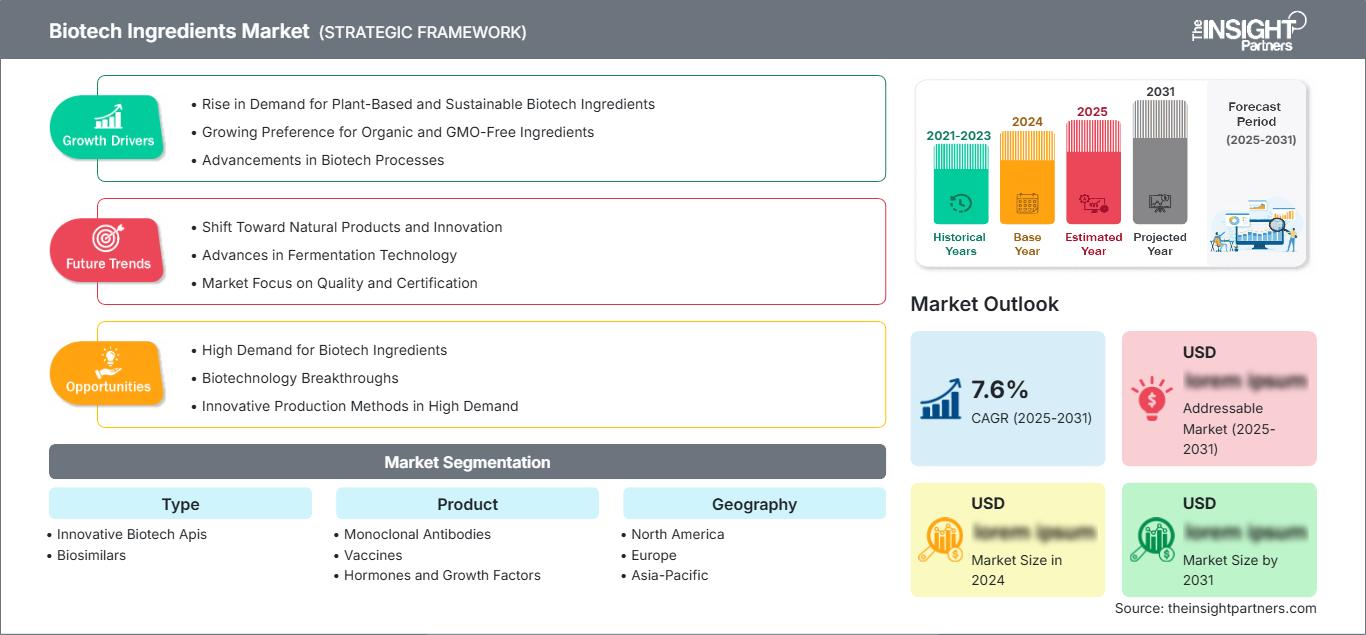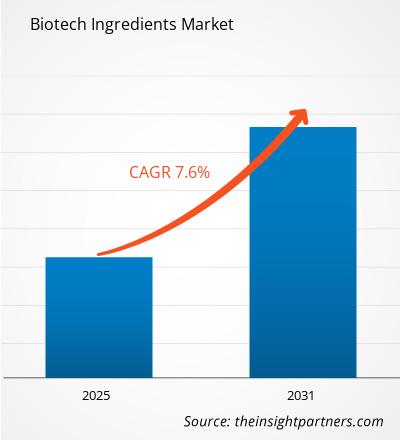Se espera que el mercado de ingredientes biotecnológicos registre una CAGR del 7,6 % entre 2025 y 2031, con un tamaño de mercado que se expandirá de US$ XX millones en 2024 a US$ XX millones en 2031.
El informe del mercado de ingredientes biotecnológicos abarca el análisis por tipo (API biotecnológicas innovadoras, biosimilares); producto (anticuerpos monoclonales, vacunas, hormonas y factores de crecimiento, citocinas, proteínas de fusión, enzimas terapéuticas, factores sanguíneos); sistema de expresión (sistemas de expresión en mamíferos, sistemas de expresión microbiana, sistemas de expresión en levaduras, sistemas de expresión en insectos). El análisis global se desglosa a nivel regional y por países principales. El informe ofrece el valor en USD para el análisis y los segmentos mencionados.
Propósito del Informe
El informe "Mercado de Ingredientes Biotecnológicos" de The Insight Partners busca describir el panorama actual y el crecimiento futuro, los principales factores impulsores, los desafíos y las oportunidades. Esto proporcionará información a diversas partes interesadas del negocio, como:
- Proveedores/fabricantes de tecnología: Para comprender la dinámica cambiante del mercado y conocer las oportunidades potenciales de crecimiento, lo que les permitirá tomar decisiones estratégicas informadas.
- Inversores: Realizar un análisis exhaustivo de tendencias respecto a la tasa de crecimiento del mercado, las proyecciones financieras del mercado y las oportunidades que existen en toda la cadena de valor.
- Órganos reguladores: Regular las políticas y las actividades policiales en el mercado con el objetivo de minimizar el abuso, preservar la confianza de los inversores y defender la integridad y estabilidad del mercado.
Segmentación del mercado de ingredientes biotecnológicos
Tipo
- API biotecnológicas innovadoras
- Biosimilares
Producto
- Anticuerpos monoclonales
- Vacunas
- Hormonas y factores de crecimiento
- Citocinas
- Proteínas de fusión
- Enzimas terapéuticas
- Factores sanguíneos
Obtendrá personalización en cualquier informe, sin cargo, incluidas partes de este informe o análisis a nivel de país, paquete de datos de Excel, así como también grandes ofertas y descuentos para empresas emergentes y universidades.
Mercado de ingredientes biotecnológicos: Perspectivas estratégicas

-
Obtenga las principales tendencias clave del mercado de este informe.Esta muestra GRATUITA incluirá análisis de datos, desde tendencias del mercado hasta estimaciones y pronósticos.
Factores que impulsan el crecimiento del mercado de ingredientes biotecnológicos
- Aumento de la demanda de ingredientes biotecnológicos sostenibles y de origen vegetal: la preferencia de los consumidores está aumentando por los ingredientes biotecnológicos sostenibles y de origen vegetal, lo que impulsa el crecimiento en el mercado global en los sectores de alimentos, cosméticos y farmacéuticos.
- Creciente preferencia por ingredientes orgánicos y libres de OGM: los estudios indican un cambio hacia ingredientes orgánicos y libres de OGM, lo que impulsa el mercado de ingredientes biotecnológicos en diversas industrias.
- Avances en los procesos biotecnológicos: Los avances en los procesos biotecnológicos, como la fermentación y la producción basada en enzimas, respaldan la creciente demanda de ingredientes biotecnológicos.
Tendencias futuras del mercado de ingredientes biotecnológicos
- Cambio hacia productos naturales e innovación: Las estrategias de mercado resaltan la tendencia creciente hacia la innovación basada en plantas y el fuerte crecimiento de los productos naturales.
- Avances en la tecnología de fermentación: las mejoras en la tecnología de fermentación están impulsando una producción más eficiente de ingredientes biotecnológicos, y los principales actores se están centrando en optimizar los procesos para ampliar la escala.
- Enfoque del mercado en la calidad y la certificación: el cambio hacia ingredientes biotecnológicos certificados y de alta calidad está influyendo en las estrategias del mercado, enfatizando la seguridad del consumidor y el cumplimiento de las regulaciones globales.
Oportunidades de mercado para ingredientes biotecnológicos
- Alta demanda de ingredientes biotecnológicos: la creciente tendencia hacia ingredientes alimentarios funcionales, sostenibles y de origen vegetal está impulsando una alta demanda de ingredientes biotecnológicos, especialmente en América del Norte, Europa y Asia.
- Avances en biotecnología: Las innovaciones en biotecnología, como el uso de enzimas y microorganismos para una mejor producción de ingredientes, abren oportunidades de crecimiento en los sectores de alimentos, cosméticos y farmacéuticos.
- Métodos de producción innovadores en alta demanda: las empresas que se centran en técnicas de producción innovadoras pueden capturar una participación de mercado significativa en la creciente industria de ingredientes biotecnológicos.
Perspectivas regionales del mercado de ingredientes biotecnológicos
Los analistas de The Insight Partners han explicado detalladamente las tendencias regionales y los factores que influyen en el mercado de ingredientes biotecnológicos durante el período de pronóstico. Esta sección también analiza los segmentos y la geografía del mercado de ingredientes biotecnológicos en América del Norte, Europa, Asia Pacífico, Oriente Medio y África, y América del Sur y Central.
Alcance del informe de mercado de ingredientes biotecnológicos
| Atributo del informe | Detalles |
|---|---|
| Tamaño del mercado en 2024 | US$ XX millones |
| Tamaño del mercado en 2031 | US$ XX millones |
| CAGR global (2025-2031) | 7,6% |
| Datos históricos | 2021-2023 |
| Período de pronóstico | 2025-2031 |
| Segmentos cubiertos |
Por tipo
|
| Regiones y países cubiertos |
América del norte
|
| Líderes del mercado y perfiles de empresas clave |
|
Densidad de actores del mercado de ingredientes biotecnológicos: comprensión de su impacto en la dinámica empresarial
El mercado de ingredientes biotecnológicos está creciendo rápidamente, impulsado por la creciente demanda del usuario final debido a factores como la evolución de las preferencias de los consumidores, los avances tecnológicos y un mayor conocimiento de los beneficios del producto. A medida que aumenta la demanda, las empresas amplían su oferta, innovan para satisfacer las necesidades de los consumidores y aprovechan las tendencias emergentes, lo que impulsa aún más el crecimiento del mercado.

- Obtenga una descripción general de los principales actores clave del mercado de ingredientes biotecnológicos
Puntos clave de venta
- Cobertura integral: el informe cubre de manera integral el análisis de productos, servicios, tipos y usuarios finales del mercado de ingredientes biotecnológicos, proporcionando un panorama holístico.
- Análisis de expertos: el informe se compila con base en el conocimiento profundo de expertos y analistas de la industria.
- Información actualizada: El informe asegura relevancia comercial debido a su cobertura de información reciente y tendencias de datos.
- Opciones de personalización: este informe se puede personalizar para satisfacer los requisitos específicos del cliente y adaptarse adecuadamente a las estrategias comerciales.
Por lo tanto, el informe de investigación sobre el mercado de ingredientes biotecnológicos puede ayudar a descifrar y comprender el panorama de la industria y sus perspectivas de crecimiento. Si bien existen algunas preocupaciones válidas, las ventajas generales de este informe suelen superar las desventajas.
- Análisis histórico (2 años), año base, pronóstico (7 años) con CAGR
- Análisis PEST y FODA
- Tamaño del mercado, valor/volumen: global, regional y nacional
- Industria y panorama competitivo
- Conjunto de datos de Excel
Informes recientes
Informes relacionados
Testimonios
Razón para comprar
- Toma de decisiones informada
- Comprensión de la dinámica del mercado
- Análisis competitivo
- Información sobre clientes
- Pronósticos del mercado
- Mitigación de riesgos
- Planificación estratégica
- Justificación de la inversión
- Identificación de mercados emergentes
- Mejora de las estrategias de marketing
- Impulso de la eficiencia operativa
- Alineación con las tendencias regulatorias






















 Obtenga una muestra gratuita para - Mercado de ingredientes biotecnológicos
Obtenga una muestra gratuita para - Mercado de ingredientes biotecnológicos